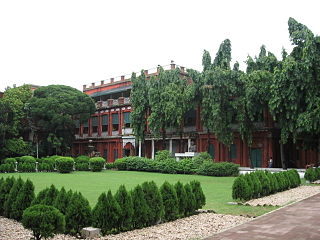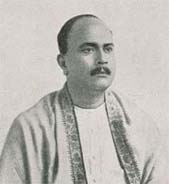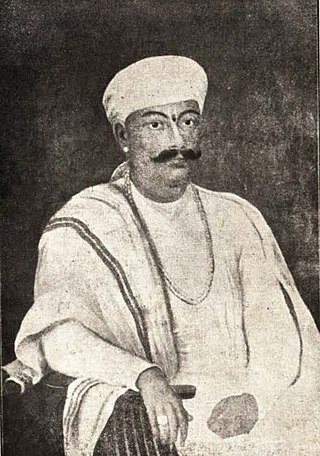
'Prince' Dwarkanath Tagore was one of the first Indian industrialists to form an enterprise with British partners. He was the son of Rammoni Tagore, and was given in adoption to Rammoni’s elder brother Ramlochan Tagore. He was the scion of the Tagore family of Calcutta, father of Debendranath Tagore and grandfather of Rabindranath Tagore.

Ishwar Chandra Bandyopadhyay was an Indian educator and social reformer of the nineteenth century. His efforts to simplify and modernise Bengali prose were significant. He also rationalised and simplified the Bengali alphabet and type, which had remained unchanged since Charles Wilkins and Panchanan Karmakar had cut the first (wooden) Bengali type in 1780.

Suchitra Mitra was an Indian singer, composer, artist exponent of Rabindra Sangeet or the songs of Bengal's poet laureate Rabindranath Tagore, professor, and the first woman Sheriff of Kolkata. As an academic, she remained a professor and the Head of Rabindra Sangeet Department at the Rabindra Bharati University until 1984. Mitra was a playback singer in Bengali films and was associated for many years with the Indian People's Theatre Association.

Jorasanko is a neighbourhood of North Kolkata, in Kolkata district, West Bengal, India. It is so called because of the two (jora) wooden or bamboo bridges (sanko) that spanned a small stream at this point.

Jyotirindranath Tagore was a playwright, musician, editor, and painter from Bengal. He played a major role in the flowering of the talents of his younger brother, the first non-European Nobel Prize winner, Rabindranath Tagore.

Kumortuli is a traditional potters' quarter in North Kolkata in West Bengal, India. The city is renowned for its sculpting prowess. It not only manufactures clay idols for various festivals but also regularly exports them.

Bagbazar is a neighbourhood of North Kolkata, in Kolkata district in the Indian state of West Bengal. The area, under Shyampukur police station of Kolkata Police, has been, along with neighbouring Shyambazar, the citadel of the Bengali aristocracy. Bagbazar has played an active role in growth and development of Kolkata.

Janbazar is a neighbourhood of Central Kolkata, in Kolkata district in the Indian state of West Bengal. The two century-old house of Rani Rashmoni, the central attraction in Janbazar, is still used by descendants in the family.

Bowbazar, also spelt Boubazar; formerly known as Bahubazar) is a neighbourhood of Central Kolkata, in Kolkata district in the Indian state of West Bengal.
Barowari refers to the public organisation of a religious entity, mainly in West Bengal, India. Barowari has significance associated with the Durga Puja festival, in which the Hindu Goddess Durga is worshipped; symbolising the victory of good over evil. The word "Barowari" comes from the Sanskrit words "bar", which means public, and Persian word "wari", means For.

Jorabagan is a neighbourhood of North Kolkata, in Kolkata district, in the Indian state of West Bengal. As a neighbourhood, it covers a small area but its importance is primarily because of the police station.

Posta is a neighbourhood in North Kolkata, in Kolkata district in the Indian state of West Bengal. Once a citadel of Bengali mercantile aristocracy, it is now an extension of the whole sale market in neighbouring Burrabazar, dominated by Marwaris. The wholesale market features a wide range of products such as edible oil, salt, cereals, spices, food grains, sugar, and vanaspati products.

Burrabazar is a neighbourhood of Central-North Kolkata, in Kolkata district in the Indian state of West Bengal.

Shobhabazar is a neighbourhood of North Kolkata, in Kolkata district, in the Indian state of West Bengal.
Tagore is a surname held by the Tagore family. Notable people with the surname include:
Kali Babur Bari is located in Janai, Hoogly, West Bengal.

Atul Prasad Sen was a Bengali composer, lyricist and singer, and also a lawyer, philanthropist, social worker, educationist and writer.

Raja Gopi Mohan Tagore (1760–1819) was scion of the Pathuriaghata Tagore family and noted zamindar and philanthropist from Bengal region of the Indian subcontinent.





















